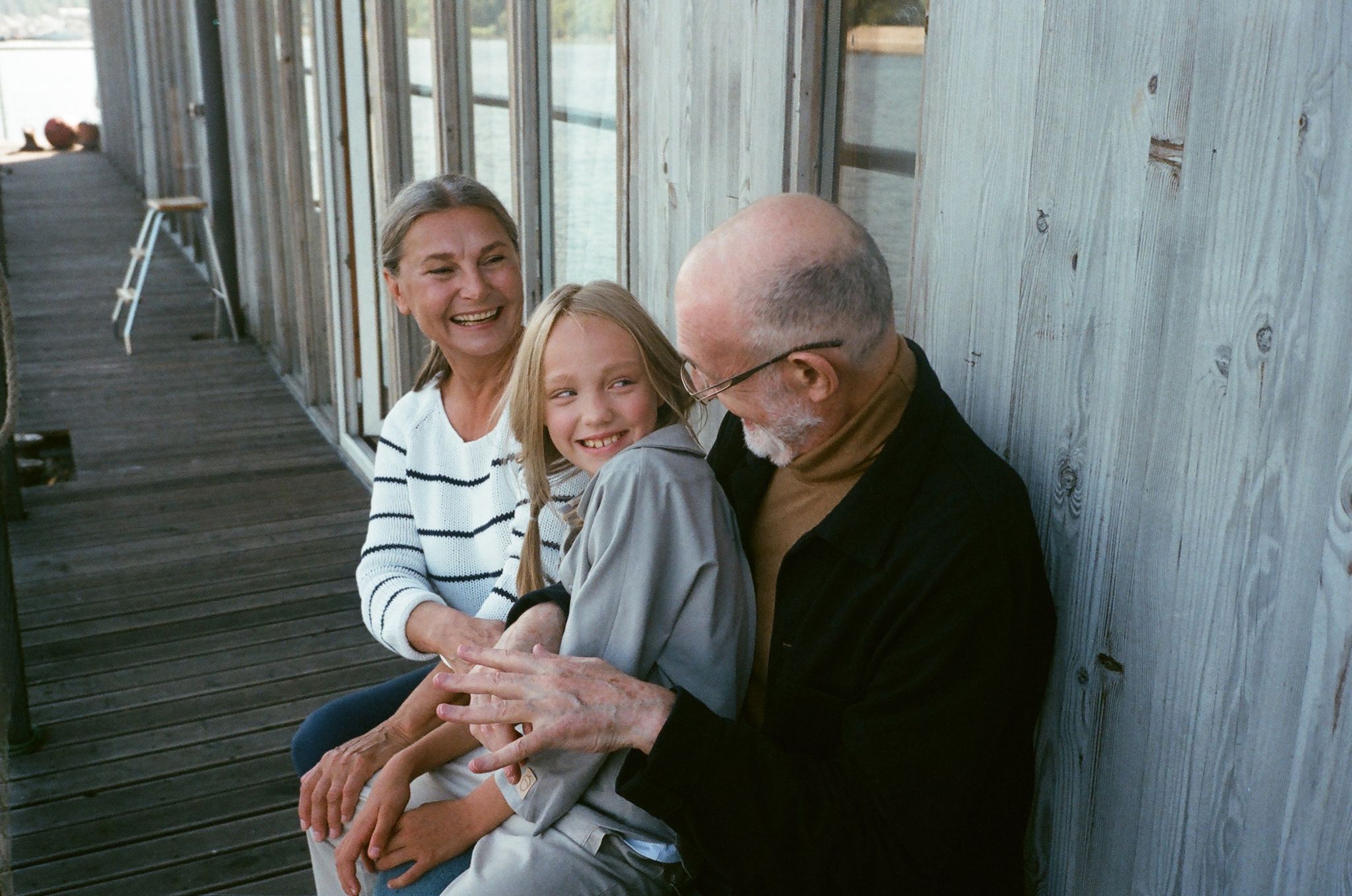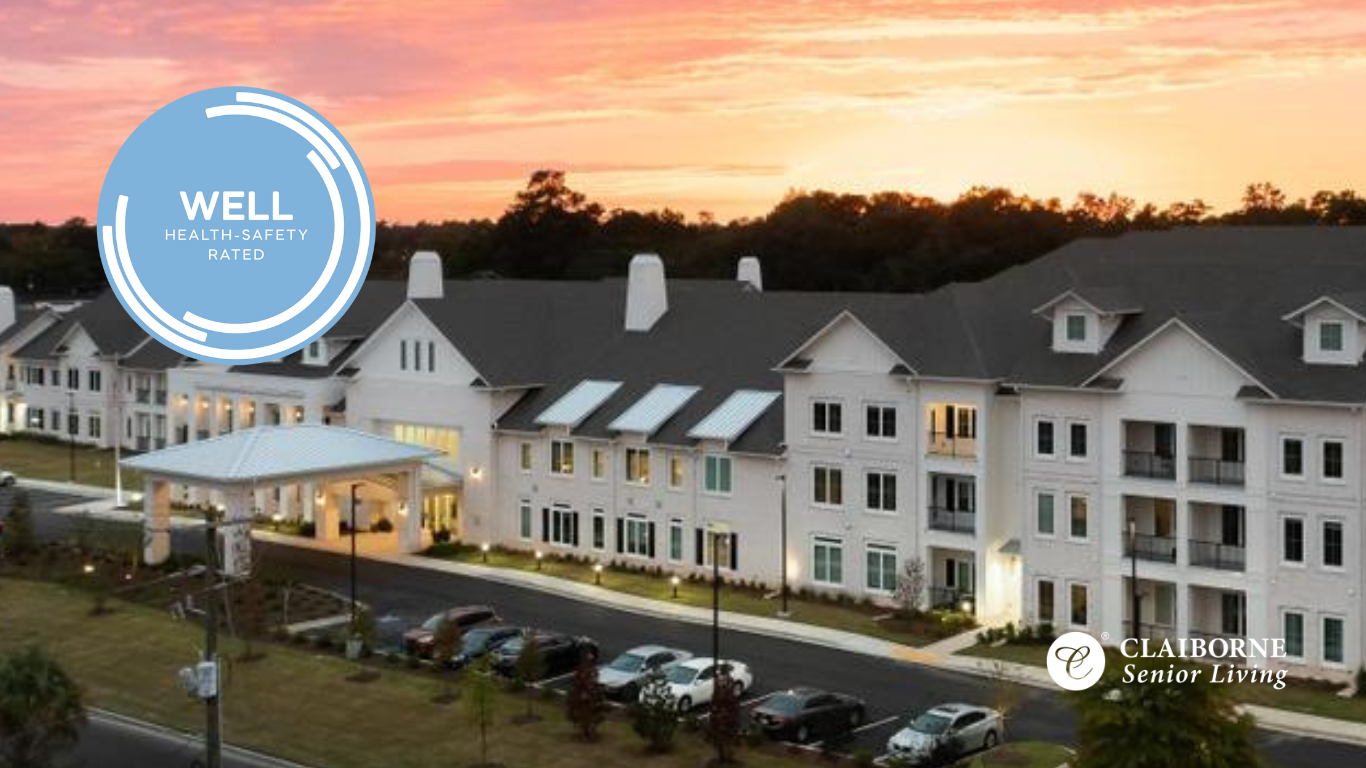A Claiborne Senior Living Guide
Deciding to move into a senior living community has implications not only for you, but also for your family. Here’s how to talk it out in a way that’s both sensible and sensitive.
Start Read
[arrow-down]
Is It Time for Senior Living?
The decision is yours–but making it is easier when your family supports you.

For many seniors, older adulthood eventually brings with it an “aha”moment. It could be early in the morning at the kitchen table, when you’re sipping hot coffee in an empty house that was made for six instead of two. It might be when you find yourself getting winded carrying laundry up the stairs, or when your spouse slips in the shower and nearly breaks a bone. Or maybe it will come on a Saturday night, wishing you were engaged in a boisterous game of canasta with friends instead of nodding off yet again in front of the television. Whenever and wherever it appears, what you’ll probably think to yourself when it comes is, “Maybe it’s time for a change.”
Aging isn’t the end of the road.
Rather, it’s the beginning
of a new one.
And maybe it is. By the time you reach retirement age, the children you spent your adult life raising are grown. The friends with whom you made your favorite memories have moved on. The hobbies you used to enjoy are no longer fulfilling. And even the most routine household chores have become a lot harder to do.
But aging isn’t the end of the road. Rather, it’s the beginning of a new one. When it’s no longer serving you, letting go of the lifestyle you had can make room for the lifestyle you want.

Whatever it entails—time with family, traveling, yoga, gardening or golf, to name just a few of the infinite possibilities—that lifestyle might become more attainable by moving to a senior living community. There, in a home that’s made for aging, surrounded by useful services, attractive amenities and scores of new friends, your next chapter can be simpler, safer and more satisfying.
Even so, the decision to embrace senior housing is as difficult as it is big. For that reason, it can be helpful to have the support of loved ones as you make it. But family members’ support doesn’t always come easy. What feels practical, prudent and preferable to you might seem sudden, impulsive and ill-considered to them. This is particularly true in the case of adult children, for whom parents’ aging can be especially impactful from a social, emotional and even financial point of view.
Still, it’s important to talk. Whether your loved ones are welcoming of the idea or wary of it, discussing your future in a senior living community can bring parents, children and siblings closer together in ways that benefit the entire family for years to come—that is, as long as you approach the conversation in ways that are caring, considerate and informed. Using this guide to plan your discussion will ensure that you do.


Before The Talk

Think Before You Speak
Making a plan will help the conversation go smoothly.
If you’re thinking about moving to a senior living community, you’re probably waiting for “the right time” to broach the subject with your adult children and other family members. Unfortunately, rarely is there ever an ideal time to have a difficult chat. Instead of waiting for a conversational door to magically appear, a better approach is to build the door yourself. And that takes planning. Here are four things you should do to prepare:

1. Understand Your Options.
When you tell your family that you want to move into a senior living community, what they might hear from you is, “I’m ready to go to a nursing home.” But senior living communities aren’t nursing homes. Senior housing today encompasses a diverse menu of safe, comfortable and dignified choices that allow seniors to live as independently as they want to, with as much—or as little—assistance as they need.
Before you discuss senior living with your family, it’s a good idea to make sure you understand what those choices are so that you can explain to your loved ones what your plan entails and how it will help you achieve the medical, emotional, social and/or financial goals that you have set for yourself. In particular, you’ll want to understand the difference between the following types of communities:
INDEPENDENT LIVING COMMUNITIES
Comprising age-restricted neighborhoods or campuses of apartments, condominiums or even single-family homes, independent living communities are designed for self-sufficient seniors who want to be part of a community while also maintaining their independence and privacy. Amenities like dining services, housekeeping, home maintenance and organized activities can ease the burdens of senior living without threatening seniors’ autonomy.
ASSISTED LIVING COMMUNITIES
Like independent living communities, assisted living communities offer residences and amenities that make life easier and safer for the seniors who live in them. For the older adult who needs it, they offer baked-in assistance with daily activities like medication management, bathing, dressing and transportation.
MEMORY CARE COMMUNITIES
Memory care communities offer assisted living for seniors with cognitive illnesses like Alzheimer’s disease and dementia. Because Alzheimer’s and dementia care can present unique challenges, they feature staff, services and social activities that are tailored to residents’ special needs.
SKILLED NURSING FACILITIES
Skilled nursing facilities offer 24-hour supervised care for seniors who have severe physical or cognitive illnesses that make them dependent on others for even the most basic aspects of daily living.
LIFE PLAN COMMUNITIES
Also known as continuing care retirement communities, or CCRCs, life plan communities are designed to be dynamic and flexible by offering independent living, assisted living, memory care and skilled nursing all in the same place. In so doing, they allow seniors to live out their retirement in the same community—safe, secure and stable—no matter how their needs might change as they age.

2. Clarify Your Goals And Wishes.
Even if you do a good job explaining what modern senior living communities look like, your family members might have a hard time seeing past negative stereotypes and emotional assumptions. For that reason, it’s important that you be able to express not only where you want to spend your golden years, but also why you want to spend them there. Here are a few of the most common reasons that seniors give for moving into a senior living community. Before you speak to your family, think about which ones resonate most with you.
SAFETY
When they think about retirement, most people assume they will want to age in place. When their body stops working the way it used to, however, reality often sets in. When that happens, seniors often realize that aging in place can come with significant risks, including falls—the leading cause of injury among adults 65 and older thanks to their limited mobility—decreased eyesight and increased fragility. For older adults, even minor falls sustained doing routine household chores can have major implications, including broken bones and fractures, head injuries, permanent disability and even death.
Senior living communities often have accessible residences that are designed for seniors’ safety, as well as amenities like meal service and housekeeping that preclude seniors from having to perform potentially dangerous household chores.

Health and Wellness
Even if you manage to avoid falling, you’ll still be prone to medical emergencies. What happens if you have a heart attack, for instance, or a stroke? What if you mix up your medications, or have an allergic reaction? And what about diet and fitness? Malnourishment and muscle loss can be common in seniors, many of whom stop shopping, eating and exercising when it becomes more difficult for them to drive and walk.
Certain types of senior housing, like assisted living communities, have medical personnel onsite who can assist in the event of a medical emergency. Many have meal services that ensure proper nutrition, and most offer amenities and activities to help residents stay active and fit.
Financial Security
Money is a common concern for seniors, many of whom live on a fixed income. If you were to experience a financial emergency, would you be OK? A medical event, for example, could be just as hurtful to your wealth as it is to your health. A home disaster, such as a broken furnace or flooded basement, could be equally disruptive. And then there are financial fraudsters, for whom seniors are often easy prey. Even something as routine as paying bills can become problematic for older adults, whose failing eyesight and limited technological expertise could lead to missed or mispaid bills, which in turn can lead to cancellation or interruption of critical services.
Senior living communities offer stable and predictable expenses, which makes financial planning and management simple. Plus, many communities offer tiered services that can flex to fit any budget.

Socialization
As they age, seniors often see less of friends and peers. Some of them retire to distant places. Some become ill or disabled. Some become isolated due to lack of mobility. Still others pass away. Meanwhile, grown children who used to consume so much of their time become busy with careers and families of their own. The cumulative effect for many older adults is a smaller social circle that can lead to feelings of isolation and loneliness.
Senior living communities are designed with socialization in mind, offering ample opportunity to participate in organized activities as well as impromptu social engagements.
Support
When friends and family are absent, it’s not just seniors’ social lives that suffer. It’s also their support system. Suddenly, they have no one to check in on them to make sure they’re OK. That can have consequences not only for their mental health, but also for their physical well-being. For example, imagine a natural disaster; in the event of a major tornado, blizzard, earthquake or hurricane, who would make sure you had food, water and heat, or helped you evacuate if it was no longer safe to shelter in place?
Senior living communities have built-in support in the form of neighbors and friends, as well as professional staff. Most communities have essential goods, emergency systems and well-considered preparedness plans they can quickly execute should a major event occur.

Mental Acuity
Aging doesn’t just impact the body. It also impacts the mind. In particular, memory loss from Alzheimer’s disease and dementia can create its own kinds of safety concerns. Seniors with cognitive illness, for example, may be prone to wandering and might endanger themselves with simple acts of absentmindedness, like leaving a hot stove unattended.
Many senior living communities offer memory care services that are designed especially for seniors with Alzheimer’s and dementia.
While you’re contemplating how you can benefit from living in a senior living community, consider how your family can benefit as well. If you decide to age in place, at some point you’ll likely need increased support and supervision from your adult children or other relatives, each of whom has their own family, job and other responsibilities to tend to. Will your loved ones have the time to be a full- or even part-time caregiver? To help on a routine basis with groceries and household chores? What about the social and emotional bandwidth that caregiving requires? A senior living community can help you maintain the treasured roles and relationships you have—parent and child, for instance, instead of caregiver and dependent.

3. Prepare An Outline.
When it comes to something as sensitive as aging, it may feel most natural to speak from the heart. And you should, because sincerity is important. It’s also important, however, to be prepared, organized and cogent. If you leave your remarks to chance, you might forget to say something important, and could end up meandering in ways that make your decision appear hasty and ill-conceived.
To come off as both authentic and informed, prepare a loose agenda or outline prior to speaking with your family members—something that you can consult as you talk, but which you won’t read verbatim. Because talks about senior housing can be extremely emotional and stressful, writing down the things you want to say and the points you want to make can ensure that conversations are focused, rational and productive, but also genuine and heartfelt.
4. Anticipate Questions
Remember that conversation is by nature a two-way street. While it’s important to prepare what you want to say, it’s just as critical that you be ready to hear your family members’ response. They’ll have feelings to share, but also questions to ask. Lots and lots of questions. If you already have a senior living community in mind, for example, they might want to know the size and setup of the residences, what the monthly rent will be, whether meals are provided, what other services are and aren’t included, and whether Medicare or Medicaid will help with the costs. As much as you can, try to anticipate what questions they will have, and to prepare answers to demonstrate that you’ve done your homework. Having brochures and other literature available to share also can be helpful.


The Talk

A Fruitful Family Meeting
Empathy and earnestness are the keys to constructive conversation.
Ultimately, all your planning and preparation are groundwork for a single moment: convening a family meeting to finally announce your senior-living wishes. Like other family meetings you may have had over the years, the ensuing conversation might be unsettling and uncomfortable. But it’s also really important. Keeping in mind the following advice will ensure that everyone feels heard so you can build your future with the support of a family that’s united instead of divided.

1. Make A Date.
When, where and how you have the talk can be just as important as what you say. The first thing you should do is to arrange having the conversation at a time and place that’s convenient for your loved ones. Instead of blindsiding them over dinner in a public restaurant, for example, tell them ahead of time that you’d like to have a serious conversation, then let them decide where they’d like to have it. That gives them time to prepare themselves, and makes them feel like they have agency in the discussion they’re about to have with you.
2. Break The Ice.
Starting the discussion often is the most difficult part of it. To get things off on the right foot, consider different ways to break the ice. For instance, you could:
Emphasize Your Desires
Your family doesn’t want to deprive you of things that will bring you joy, so that can be a good place to start. Maybe you’ve always dreamed about traveling, for example. Maybe you love to garden, but don’t have the space to do it at home. Or maybe you’re really excited by the prospect of making new friends. Whatever it is, focusing on what you will gain by moving to a senior living community can be an effective way to build support and enthusiasm for the idea.
Acknowledge Obstacles
Have you had health scares or memory problems? Are you having a hard time doing housework or grocery shopping? Are you lonely or isolated? Instead of pretending that everything is fine, consider admitting to your family that you are facing new challenges as you age. When they’re confronted with the reality of your situation, family members may be more receptive to the idea of a senior living community as a practical solution to real problems.
Share Success Stories
As previously mentioned, family members may have false impressions and negative stereotypes about what a senior living community is. A good way to dispel myths and rally support is to share positive anecdotes from friends and relatives who have already made the transition to senior living—particularly those your family members know, like a cousin your adult children remember from family reunions, or a close family friend who they always looked up to.
Focus On The Family
Although it’s your future, there undoubtedly are implications for your family members, too. Focusing on how senior living will improve their lives as much as it will improve yours can be persuasive. If your adult daughter just started her medical residency, for example, she might appreciate knowing that she can focus on her budding career without having to worry about whether you’re taken care of. If your adult son has young kids, he might be excited to know that the senior living community you’re looking at has a community swimming pool where grandkids are welcome on family days. Or perhaps your children live in a cold climate and would jump at the opportunity to have a warm place to visit in the winter.

3. Underscore Your Independence.
If your family is concerned about your decision, it could be because they imagine senior living communities as places where seniors live sedentary lifestyles inside cloistered facilities. The refreshing reality—that many senior living communities not only encourage active, independent living, but actually make it safer and more feasible—can be eye-opening for adult children and others who are skeptical.
4. Make It Clear: This Isn’t Personal.
Adult children in particular might take it personally when you tell them that you want to live in senior housing. They might have imagined, for example, that you would eventually move in with them when you needed extra support. Or maybe you already do live with them, in which case they might feel hurt that you have decided you’d be happier elsewhere. In the case of assisted living communities, adult children might also have a hard time entrusting your well-being to others, insisting that no one will be able to give you the same level of care and love that they can give. If you sense that your loved ones feel wounded by your wishes, the best thing you can do is reiterate your motivations and reassure them that your choice has nothing to do with them. They didn’t do anything wrong or push you away; rather, you’re simply ready to pursue new goals in a new environment.

5. Embrace Empathy.
Even if your family doesn’t take your decision personally, they might have other objections. For example, perhaps your adult children were counting on you for childcare that you’ll no longer be able to provide. Maybe they’re worried that your decision will have financial implications for them—that they will have to help you cover the costs of senior living, for example, or that you will spend their inheritance on rent. Or perhaps your aging simply makes them feel insecure about their own advancing years.Whatever they are, their concerns are real, even if you don’t believe them to be valid. For that reason, the most important thing you can bring to your conversation with family is empathy. Change is hard to process, and aging is emotional. Before you become defensive or combative, try to put yourself in your family’s shoes. Remain calm, honest and rational, even if they cannot. If you can be continually aware of their concerns and unflinchingly respectful of their feelings, cooler heads eventually will prevail.
6. Practice Active Listening.
Remember, this is supposed to be a conversation. That means not just talking, but also listening. Often, family members who have objections or concerns simply want to be heard as they process the new choices and challenges that you’re facing. You can do your part to help them through it by being silent and attentive, by not interrupting, by withholding judgment, by asking insightful questions and by repeating their points back to them so they know you understood them.


After The Talk

Next Steps
You’ve started the conversation; now, you’ve got to keep it going.
Keep in mind that the senior-living conversation is rarely a single conversation. More often, it’s a series of progressive conversations that take place over time. If you don’t get the accord you were seeking right away, that’s OK. If you continue to make and repeat your points, your family eventually will hear you out.
As the conversation continues, there are things you can do to move the needle in a positive direction. For example:
Meet with a financial advisor
Money can be one of the biggest concerns for family members who are skeptical of senior housing. Although they want to support you emotionally, they worry whether they will be able to support you financially. Meeting with a financial advisor can help you and your loved ones understand what resources you need, what resources you have and what might be required to fill the gap between them if there is one. Importantly, a financial advisor also can help you compare the costs of living in a senior living community to the costs of aging in place. When you consider the money you might spend over time on home maintenance, in-home healthcare and other expenses, the latter isn’t always as affordable as it seems.
Take A Tour
Talking about a senior living community is one thing. Actually seeing a community is something else entirely. If you’re still trying to decide on a community, invite your family members to join you on tours. And if you’ve already chosen a community, schedule a time to visit it with them. Although they may still have reservations, family members often end up excited for you when they see firsthand what your life is going to look like and the ways in which it might improve.
Delegate Duties and Decisions
Ultimately, where you want to live is your choice. Involving family members in the process, however, can make them feel important and engaged. That, in turn, can build buy-in. For instance, you could task adult children with helping you find potential communities to tour and explore. Or if you’ve already chosen a community, you could ask loved ones to help you do research about the area around it, or help execute your move by hiring movers, organizing a garage sale or planning a housewarming party.
Wherever you choose to spend the next phase of your life, the change is bound to be both scary and exciting. You don’t have to do it alone. Your family and friends can be thereto help you, to provide support and cheer you on. First, though, you have to invite them in. There might be conflict along the way, but in the end you’ll be glad that you did.
Navigate
Share This Post

































